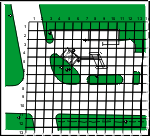Modeling Subsurface Petroleum Hydrocarbon Transport
Application of ModelsOnce we understand contaminant transport, we can begin to apply models. This portion of the course contains four major themes:
|
||||
Introduction to MathematicsThe intent of this course is not to emphasize mathematics. There are, however, certain mathematical aspects of models that must be understood in order to appreciate features of model results. This section is as brief as possible. Back to top |
||||
Introduction to Model ApplicationBeyond the mathematics, there are a range of important considerations for model application. These include the dimensionality of the model (1D, 2D, or 3D), treatment of the contaminant source, and other boundary conditions. This is the area where much of the art of modeling resides. We'll give some of the basics, but there's much that only experience can teach. Back to top |
||||
Back to top |
||||
The Basis and Use of Selected ModelsSeveral models will be described in a fair amount of detail, tutorials will be given on how to use the models and application to sites will be shown. The models selected all have a strong tie to EPA. Because of the importance of Risk-Based Corrective Action (RBCA), one module describes the modeling basis of ASTM-RBCA. We'll use the transport and modeling principles we've learned to take a look at this approach. The Hydrocarbon Spill Screening Model (HSSM)One model that will be covered in detail is the Hydrocarbon Spill Screening Model (HSSM) which was developed by the U.S. EPA. HSSM simulates
The pre-formatted report is provided for the convenience of the user and to transmit all information about the simulation to the report recipient. HSSM version 1.20 is available from U.S. EPA at no charge. HSSM version 1.50 is currently in beta testing and will be available at the same location. LUSTRiskWhen there is a need to use a simpler approach to estimating the risk from an existing zone of residual contamination, the LUSTRisk model can be applied. LUSTRisk performs a set of dissolution calculations from a existing smear zone. The LUSTRisk conceptualization most nearly matches an instantaneous release. An Illustration from the LUSTRisk main screen: LUSTRisk is currently under development. If you would like to serve as a beta tester, e-mail Matt Small. |
||||
|
Top ^
|


